
Breaking News

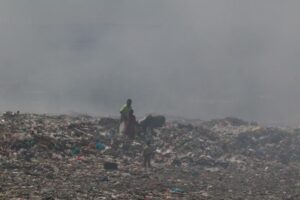
Africa, Climate Action, Conferences, Development & Aid, Environment, Featured, Headlines, Health, Sustainable Development Goals, TerraViva United Nations
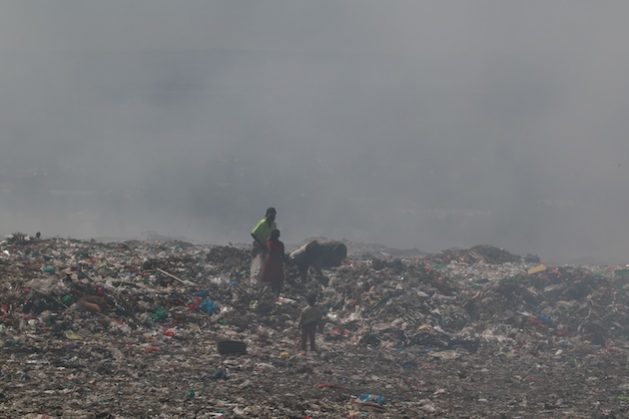
A mother and her children are seen wading through a cloud of smoke at the Dandora dumpsite, Kenya’s largest open landfill. Smoke emanating from the dumpsite is cited as a contributor to air pollution in Nairobi. Credit: Jackson Okata/IPS
– Deborah Adhiambo (43) has been battling mild asthma since 2022, a condition she describes as “both a health and economic burden.’’ The mother of three lives within Dandora Estate, nine miles east of Kenya’s capital, Nairobi. Dandora is home to Kenya’s largest open landfill, which receives more than 2,000 metric tonnes of waste daily.
For five years, Adhiambo operated a makeshift restaurant near the dumpsite, where her main clients were waste pickers working within its environs.
“Working near the dumpsite exposed me to the heavy smoke that billows from the dumpsite. I started developing chest pains gradually and would take painkillers to subdue the pain. It was later that I was diagnosed with asthma,’’ Adhiambo told IPS.
Adhiambo’s doctors told her that prolonged and constant exposure to toxic fumes was the root cause of her asthma. She was forced to close her business since she could not venture out of her house early in the morning, late in the evenings or during cold seasons.
“The closure of my business due to sickness crippled me economically as it was my only source of income. Getting medication and feeding my family has been hard because now I have to rely on my husband, who also works at the dumpsite,” she says.
Nairobi’s Air Quality
More than 70 percent of Nairobi’s 5.3 million residents live in informal settlements like Dandora, which analysts say have the worst air quality, with vulnerable populations, particularly women and children, bearing the brunt of polluted air. Vehicles, open burning of waste, and industrial emissions are cited as the major sources of air pollutants in Nairobi. Motor vehicles contribute an estimated 40 percent of Nairobi’s particulate matter (PM2.5) air pollution concentrations, with illegal dumping and open waste burning contributing 25 percent.
And as both the population and economic output of Kenya’s capital keep expanding, the demand for energy from fossil fuels is also on the rise. The rapid expansion of Nairobi has taken an environmental toll on the city, which is evident in the worsening air pollution levels. Air pollution in Kenya’s capital is 4.2 times higher than the World Health Organization’s (WHO) recommended average annual concentration levels.
According to the World Health Organization, Nairobi’s air pollution is 2.4 times higher than recommended levels, with 19,000 poor air quality deaths being reported in Kenya annually.
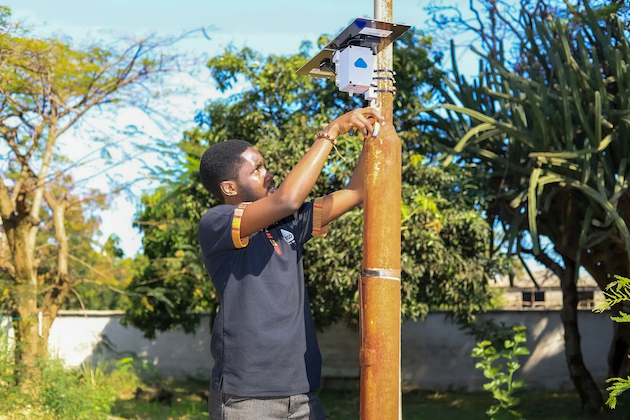
A technician installs a low-cost air quality monitor sensor in Nairobi, Kenya. Air quality monitors are helping Nairobi collect data on air pollution. Credit: Jackson Okata/IPS
Tech and Data
To enhance her efforts in combating air pollution, the City of Nairobi has been incorporating the use of technology. The city management has been installing low-cost air quality monitors and sensors to gather and share data on the levels of air pollution trends across the city. The data collected is then analyzed and guided in the formulation of policies and legal frameworks to combat air pollution, even as East Africa’s economic giant works towards realizing her ambitious target of becoming a net-zero green city by 2030.
Dubbed AirQo monitors, the low-cost air quality sensors developed by a team of young engineering and computer science students at Uganda’s Makerere University are in use in eight countries, including Kenya.
Engineer Bainomugisha, an Associate Professor of Computer Science at Makerere University and lead developer of the AirQo monitoring system, says Sub-Saharan Africa lacks usable air quality data that can help in the formulation of proper and effective policies to combat air pollution. AirQo monitors collect information about air pollution levels, types of air pollutants, and air quality
Bainomugisha explains that the air quality monitors main aim is to “close the existing gap in air quality monitoring.” AirQo air quality monitors collect air samples, which are then analyzed through a light scattering technology that quantifies the particulate matter concentration.
The information is then relayed to a cloud-based network that determines the pollution levels in a specific area. The devices measure the air particulate matter PM2.5 and PM10, which is a mixture of solid particles in the air. They also capture ambient meteorological conditions such as humidity and atmospheric pressure
“The air quality monitors run on a 2G GSM-enabled network configuration for loT sim cards and are optimized to work in areas with unstable internet and power connectivity,” says Gideon Lubisia, AirQo’s international operations embedded systems and network support engineer.
AirQo has also developed a mobile app that allows people to receive periodic and real-time updates on the air quality in their city. The monitors are mounted at strategic points within the city’s Central Business District, industrial areas, markets, along major city highways and in select residential areas. while others are mounted on motorbikes that move from one location to another, collecting data.
Data and Policy Formulation
With the monitors in place, Nairobi City has been able to develop two air quality collocation installations and infrastructure reference grade monitors, according to Nairobi City County Deputy Director in Charge of Air Quality and Climate Maurice Kavai.
“The one-stop center collocation enables our research teams to compare air quality data collected from various points within the city, which is key in developing appropriate action,” Kivai explained.
“The availability of periodic data collected by the monitors enables the city to establish the extent of pollution in particular areas, identify the causes, and develop necessary actions,” he said.
Through air quality data collected through the monitors and establishing the extent of air pollution in the city, Nairobi has been able to develop a city Air Quality Action Plan as well as enact the Nairobi City County Air Quality Act which have become critical policy and legal assets in tackling the problem of air pollution.
AirQo monitors are now in use within select cities in eight African countries, including Uganda, Kenya, Nigeria, Cameroon, Burundi, Ghana, Mozambique, and Senegal.
Global Push for Clean Air
During the Climate and Clean Air Conference(CCAC) 2024 in Nairobi between February 21 and 23, 2024, ahead of the sixth session of the UN Environment Assembly (UNEA-6), member states and partners launched a Clean Air Flagship effort to provide, among other things, data-led policy action towards combating air pollution
Inger Andersen, UNEP’s Executive Director, said, “We need to push harder on superpollutants. Just as you need a superhero to defeat a supervillain, we need super solutions to face down super pollutants. And we need you to mastermind these solutions.”
Speaking on the sidelines of the CCAC, Kenyan environmentalist Elizabeth Wathuti observed that “the very essence of life starts with a breath, a gasp of air that signifies the beginning of our journey on this Earth. Yet, for too many across our globe, this fundamental act of breathing has become a hazard, a risk, and a gamble against the odds of pollution and climate-induced adversities.” According to Wathuti, the commitment to clean air and a stable climate is not just an environmental cause but a fight for the very right to life.
The World Health Organization estimates that 99 percent of the world’s population lives in places with poor air quality, leading to nearly seven million premature deaths per year, primarily in low- and middle-income countries.
According to UNEP, in Africa alone, ambient air pollution caused an estimated 400,000 premature deaths in 2019, while indoor air pollution caused more than one million premature deaths in the same year. Some of the leading air pollution-related ailments that contribute to these premature deaths include pneumonia, heart disease, stroke, diabetes, chronic lung disease, and lung cancer. Ambient air pollution and household air pollution are associated with 6.7 million premature deaths annually.
IPS UN Bureau Report
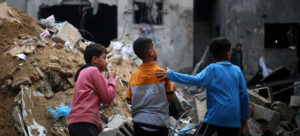
Armed Conflicts, Civil Society, Featured, Global Governance, Headlines, Human Rights, Middle East & North Africa, TerraViva United Nations
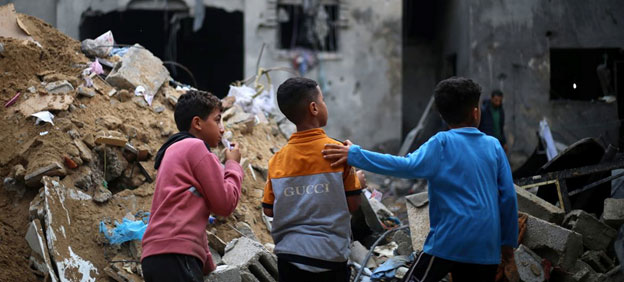
Children look at their destroyed homes in Rafah city, in the southern Gaza Strip. Credit: UNICEF/Eyad El Baba
– Nothing could prepare me for my recently concluded mission into the Gaza Strip, where children face catastrophic conditions.
In my twenty years with UNICEF, traveling from one humanitarian crisis to the next – from famines to floods and war zones to refugee camps – I’ve simply never seen such devastation and despair as is happening in Gaza.
The intensity of the attacks, the massive number of child casualties, the desperation and panic of the people on the move – people who already have nothing – is palpable. It is humanitarian disaster on top of humanitarian disaster.
Near the start of the recent brief pause in fighting, we set out early in the morning at Rafah on the border with Egypt. Our convoy of trucks carrying vital humanitarian aid made its way slowly in a punishing journey north to Gaza City, which hadn’t seen aid in weeks.
The two cities are just 35 kilometres apart, but travelling through a war zone always makes distances seem more daunting. Along the way, I saw apartment building after apartment building, home after home, flattened by the bombings, a dystopian scene that stretched for miles.
In Gaza City I got out to look more closely at a building that had been reduced to rubble. Inside, I noticed bloodstains, but it’s impossible to know whether the people who were pulled out of this mass of concrete survived.
I will never forget how a man in his 60s walked out from the ruins of a recently bombed apartment building. At first, I thought he was indicating the number 10, as in 10 people had been killed. But he corrected this, using a stick to write in the dirt: 30. It wasn’t the number of people killed. It was the number of his extended family members killed in the blast.
This man had lost everyone, his whole extended family, everyone he loved. At the start of this war, UNICEF said Gaza was a “graveyard for children and a living hell for everyone else.” It has only gotten worse as the bombing and fighting have continued.
There was a hope that the devastation seen before the pause would not be repeated should the fighting resume. But after hearing hundreds and hundreds of rounds of artillery and more explosions, I could tell that it’s happening.
Within hours, the humanitarian pause felt too long ago.
I walked across the wreckage of what I was told was once a tight-knit community that is now broken glass, rubble and steel crunching under my feet. Homes sliced open, their contents exposed like doll houses, the inside of lives laid bare.
Against the grey rubble, eerie remnants of normalcy cropped up, like a sofa on a third-floor apartment with no walls, or a painting on the only wall left standing after a blast.
I looked at what was once a child’s bedroom, with pink blankets, a cupboard, shelves full of books, fluffy stuffed toys. It looked like the room of any 12-year-old girl, from any middle-class family, anywhere in the world. It was largely untouched. The little girl would have been safe if she wasn’t in another room with her family when the home was struck.
Driving through Gaza there’s never much time for reflection. The aid convoy needs to keep moving.
Along the route we saw the same theme repeated in neighborhood after neighborhood: basic needs are not being met. People need water and nourishment. Hospitals need medicine. This convoy has all those things. But despite our efforts and those of our UN colleagues, I know it’s not enough. It’s not nearly enough.
As one of my UNICEF colleagues noted just a couple of weeks into the war, the killing and maiming of children, abduction of children, attacks on hospitals and schools, and the denial of humanitarian access are a stain on our collective conscience. It was true then, it remains true now.
From Gaza City we pushed further north, to Jabaliya. The first thing I noticed were the piles of rotting garbage outside hospitals, offices and schools. Sanitation and rubbish collection services have broken down completely, of course, as trucks have no fuel to collect it and the conflict has displaced most of the workers who do these jobs anyway.
One hospital we visited, Al-Ahli Arab Hospital, was utterly chaotic. It was overcrowded, loud, intense. Our trucks were delivering medical supplies while wounded people were being rushed in bleeding.
We eventually made it back to the south of Gaza, to what we call the Joint Operation Centre. That’s where dozens of UN workers meet to discuss the next mission. The mood was sombre. We all know what Palestinian families need: they need more of everything, especially medicines, water, fuel, food.
But genuine safety for Gaza’s children depends on parties to the conflict ensuring that humanitarians have unimpeded access to civilians wherever they are… on our ability to bring water, essential food, nutrition supplements, fuel and other humanitarian supplies into the territory… and on parties implementing an immediate humanitarian ceasefire.
Unless those conditions are met, children in Gaza are now in danger from the sky, disease on the ground, and death from hunger and thirst. Nowhere is safe.
The children of Gaza have suffered enough. We need a humanitarian ceasefire, and peace, now.
James Elder is UNICEF’s spokesperson. Follow him @1james_elder
Source: UNICEF BLOG
IPS UN Bureau
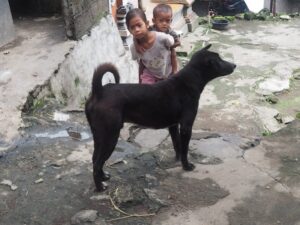
Asia-Pacific, Biodiversity, Civil Society, Conservation, Editors’ Choice, Environment, Featured, Headlines, Sustainable Development Goals, TerraViva United Nations
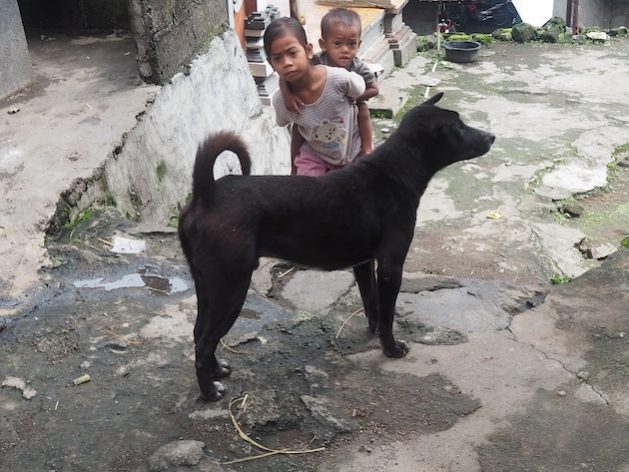
Indigenous Bali dogs hold the potential to unlock hidden secrets about ancestral dog diversity. Credit: Sonny Inbaraj/IPS
– Bali’s Island’s ancient canine guardians, the proud descendants of lineages tracing back tens of thousands of years, stand on the brink of extinction. Culling triggered by rabies outbreaks and interbreeding is pushing these living cultural treasures towards a tragic end.
For generations, traditional Bali Heritage Dogs have woven themselves into the fabric of the predominantly Hindu Balinese society. A tapestry woven with ancient folktales binds Bali dogs and the Balinese in a unique bond.
“Guided by the Tri Hita Karana’s principles of harmony and respect, Balinese Hindus forge a unique bond with dogs,” Ida Bawati Sari Budangga, a priest in Dusun Puchang in East Bali’s Desa Ban at the foot of the Gunung Agung volcano, told IPS.
Tri Hita Karana weaves harmony between humans and their environment, evident in offerings to deities and respect for nature’s bounty. Tri Hita Karana also serves as a powerful model for sustainable development, inspiring initiatives that balance human needs with environmental respect.
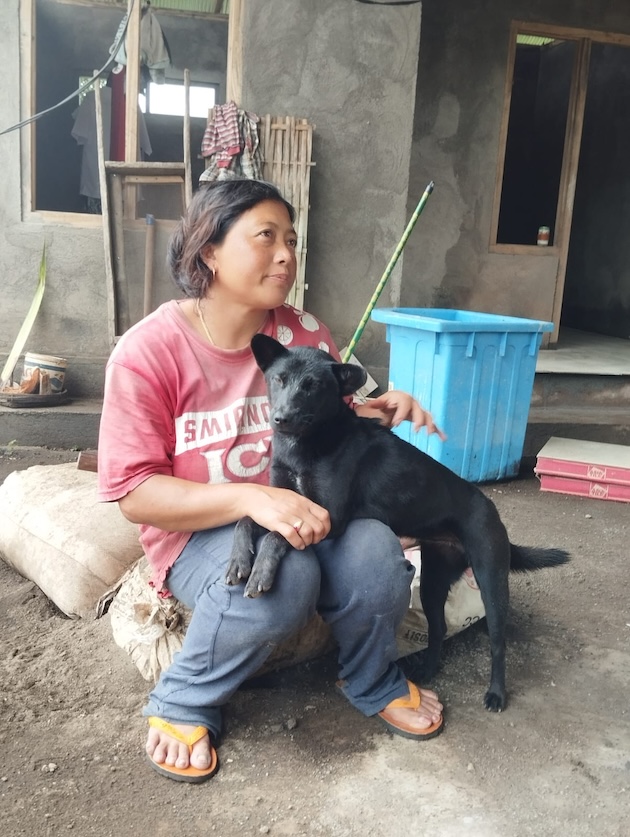
Balinese treat dogs with care, valuing their presence in their lives and communities. Credit: Dewa Made Suarjana/BAWA
“This isn’t merely pet ownership, but an embodiment of their deep connection to all living beings. From sharing meals to participating in temple rituals together, dogs are woven into the fabric of Balinese life, reflecting their reverence for the natural world and its creator,” added the priest.
In Balinese culture, the Mahabharata story of King Yudhistira and his loyal dog plays a significant role in understanding their deep respect for dogs. When Dharma, disguised as the king’s ill-kept dog, is denied entry to heaven by Indra, Yudhistira refuses to enter without him. This act of unwavering loyalty reveals Dharma’s true form as the God of righteousness, highlighting the importance of compassion and connection with all beings. This story continues to inspire the Balinese to treat dogs with respect and care, valuing their presence in their lives and communities.
Driven by interest in the Bali dog’s distinct genetic ancestry, studies such as the University of California, Davis 2005 study “Genetic Variation Analysis of the Bali Street Dog Using Microsatellites” reveal the wide diversity contained in their DNA. Microsatellites is a lab technique that uses genetic markers for studying genealogy, population organization, genome diversity, the process of evolution, and fingerprinting from extracted DNA samples.
The study found that dog populations on Bali had been separated for an estimated 12,000 years and this protracted isolation has shaped Bali’s dog genetics, resulting in distinct genetic variants absent elsewhere in other dogs.
UC Davis’ groundbreaking study unveiled an intriguing genetic link between Bali dogs and ancient Asian breeds such as the Dingo and Chow Chow. This fascinating lineage can be traced back to the Austronesian migration and colonization of South Indochina, which occurred before the last glaciation period when Bali was connected to the mainland through a land bridge that eventually submerged.
“As a result of their genetic isolation, indigenous Bali dogs hold the potential to unlock hidden secrets about ancestral dog diversity, and even shed light on ancient human migration patterns and trade routes,” commented UC Davis’ Dr Benjamin Sacks, adjunct professor, at the university’s school of veterinary medicine.
However, Sacks warned in response to the 2005 study and a study done in 2011: “We don’t have all the questions yet to ask, but they’re emerging every day, and if we lose these populations, we lose the ability to answer those questions.”
In 2008,
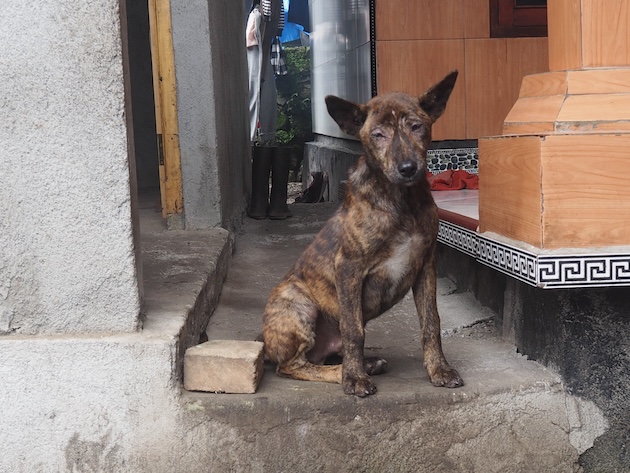
The indigenous Bali dog population has plunged from a staggering 800,000 to a mere 20,000. Credit: Sonny Inbaraj/IPS
Bali’s unique indigenous dog breed suffered a brutal blow with the knee-jerk reaction of mass culling, which continues to this day following rabies outbreaks. In a widespread plan to eliminate free-roaming dogs, the indigenous Bali dogs were not spared. Just like in other countries in Asia and Africa, rabies in Indonesia is being sustained within the domestic dog population. It’s not surprising that the public commonly associates rabies with dogs and dog bites.
According to the World Health Organization rabies is endemic in 26 provinces in Indonesia, including Bali, with 74 cases of human rabies out of 66,170 bite cases from suspected rabid animals reported in the country from January to July 2023.
Bali Island had never experienced rabies before, until 2008. Lax surveillance allowed a rabid dog to slip through from Flores, an island ravaged by endemic canine rabies since 1997, setting the stage for Bali’s own struggle with the animal-borne disease.
“Before the outbreak of rabies in 2008, the island had one of the highest dog-to-human ratios in the world,” said Janice Girardi, founder of the Bali Animal Welfare Association (BAWA).
“Mass culling was the first action that the local government authorities took in response to the rabies epidemic. They utilized teams that were armed with blow darts and baits that contained strychnine,” she added.
Culling on its own has never had an effect on rabies in dogs or humans or dog population growth, said Dr Darryn Knobel, professor at Ross University School of Veterinary Medicine in St. Kitts.
“If you’re culling, you’re going to be diverting resources away from vaccination. The only thing that works is vaccination and you need to vaccinate at least 70 percent of all dogs to get what we term herd immunity,” he explained.

An indigenous Bali dog in East Bali. Credit: Sonny Inbaraj/IPS
From 2005 to 2008, the Bali dog population was estimated to be between 600,000 and 800,000, according to a 2018 study. However, due to culling following the 2008 rabies epidemic in Bali, the population of free-ranging dogs has decreased by at least 25 percent, according to the study.
BAWA’s Girardi issued a stark warning about the indigenous Bali dog population, which has now plunged further from a staggering 800,000 to a mere 20,000, according to the NGO’s mapping.
“With such dwindling numbers,” she emphasized, “the chances of purebred dogs finding mates and perpetuating their lineage are vanishingly small, akin to winning the lottery.”
The interbreeding of native Bali dogs with dogs of other breeds that have been introduced to the island is another cause for concern. This occurred when the government of Bali, in 2004, abolished an ancient piece of legislation from 1926 that had been issued by Dutch colonialists to prevent the introduction of rabies into Bali from other islands within the archipelago.
For Balinese seeking outward signs of affluence, Western breeds and crossbreeds trump the indigenous Bali dog, deemed unworthy of attention and left wanting.
“I have one Bali dog now, but I’m planning to either get a Golden Retriever or a small long-haired crossbreed. They’re unique and good for our image,” 14-year-old I Kenang Sunia in Desa Jatituhun, Ban, in east Bali, told IPS.
Battling extinction, BAWA deploys its sterilization program to remote Balinese villages, targeting non-purebred dogs in a critical effort to conserve the dwindling population of the purebred Bali dog.
“We sterilise as many non-pure Bali dogs as possible in each area (to prevent interbreeding) in order to save the remaining indigenous dogs in Bali before they are lost forever,” said Girardi.
IPS UN Bureau Report

In this piece, we are going to look at the 15 African Countries With English As Official Language. If you want to skip our detailed discussion on the outsourcing opportunities available in the African region for businesses outside the region, you can go directly to 5 African Countries With English As Official Language.
Africa comes in as the second biggest continent in terms of size, covering about 30 million square kilometers (11.6 million square miles). It’s also the second most populated continent on the planet, with a whopping 1.48 billion folks calling it home, as of 2024. Over 24 countries exist in the vast continent of Africa where English stands as their official languages, implying the fact that so many African countries are accessible to the world without a barrier such as a language barrier.
By leveraging African talent, businesses can not only enhance efficiency and profitability but also contribute to job creation and economic growth across the continent. This is so due to a vast pool of talent and skill on the continent, which presents viable opportunities for the world outside the continent.
The outsourcing landscape in Africa is a promising opportunity for businesses looking to find fresh talent and cut down on costs. Although the advantages of outsourcing to Africa may not be widely recognized, several countries on the continent have thriving outsourcing industries. Nigeria, with its massive population of over 200 million, is actively promoting outsourcing clients from other countries through initiatives like the National Outsourcing Strategy. Furthermore, South Africa boasts advantages such as native English speakers and a favorable time zone, making it a prime destination for business process outsourcing (BPO) services. Also, South Africa is home to 133,195 software developers.
Moreover, Kenya offers a diverse landscape of BPO services covering multiple sectors, facilitated by an educated workforce and growing infrastructure. Ghana is known for its business-friendly environment, government support, and skilled English-speaking workforce, attracting companies like Trinity Software Center and ACS Ghana. Madagascar, with its reputation for having the fastest internet in Africa and competitive labor costs, sees companies like Bocasay and Oworkers excelling in IT services and data handling.
Furthermore, the education system in Africa has shown remarkable progress over the past ten years. The World Economic Forum recognized 38 African countries among the top 140 in terms of skills development in their education systems. Seychelles, Tunisia, Mauritius, South Africa, and Algeria are among the countries that have been acknowledged for their high-ranking education systems. As a result of this growth in skilled young talent entering the workforce, Africa is becoming a more competitive labor market.
By October 2020, out of the 5.8 million businesses in the U.S., around 140,918 were owned by Black entrepreneurs. Most of these Black-owned businesses, a whopping 96%, didn’t have employees, while only 80% of all small businesses fell into that category. Interestingly, about 32% of Black-owned businesses with employees were in the healthcare and social services sector.
Unfortunately, Black entrepreneurs encounter challenges like limited access to startup funds, less experience in management and industry know-how, and often operate in industries with lower revenue opportunities. Nevertheless, many businesses founded by Black/African people have turned out to be huge success; let’s shed light on some of these before we move on to our list of 15 African Countries With English As Official Language.
RLJ Lodging Trust (NYSE:RLJ) is a real estate investment trust that’s publicly traded and self-advised. They’re all about owning top-notch hotels, mostly focused-service and full-service ones that bring in good profits. Right now, they’ve got a portfolio of 96 hotels, totaling around 21,200 rooms spread across 23 states and Washington, D.C., plus a stake in another hotel with 171 rooms. Their shares have been making some moves lately, up by 0.4% in the last month and hitting a new high of $12.14 on Friday of the previous week. Since the beginning of the year, RLJ Lodging has seen a 1.2% increase, which is a bit lower compared to the finance sector as a whole but better than the REIT and Equity Trust industry.
Urban One, Inc.(NASDAQ:UONE.K) and its crew run as a cool urban-focused media company in the U.S. So, the folks holding Urban One, Inc. (NASDAQ:UONE.K) stocks might be a bit worried seeing their share price dip by 22% last quarter, ending 31st December 2023. But hey, looking back over three years, those returns would likely have put a smile on most investors’ faces. Yup, in the past three years, the share price shot up by a solid 73%, which is even better than the market average.
Broadway Financial Corp. (NASDAQ:BYFC) is the big boss behind City First Bank, which is a federally chartered savings bank. Here’s some info on the numbers: the company’s got a debt-to-equity ratio of 1.65, a current ratio of 1.13, and a quick ratio of 0.02. Their market cap sits at $56.61 million, with a PE ratio of 12.71 and a beta of 0.71. If we look at their moving averages, they’ve been cruising at $6.71 for the 50-day moving average and $7.06 for the 200-day moving average, as of the start of February 2024.

A young African American woman excitedly speaking on her smartphone while using a prepay mobile service.
To come up with our list of 15 African Countries With English As Official Language, we conducted research to first list down the African countries with English as the official language. And then to rank those countries, we used the population figures for the respective countries by referring to the data provided by World Population Review. Let’s now jump on to our list of 15 African Countries With English As Official Language.
By the way, Insider Monkey is an investing website that tracks the movements of corporate insiders and hedge funds. By using a similar consensus approach, we identify the best stock picks of more than 900 hedge funds investing in US stocks. The top 10 consensus stock picks of hedge funds outperformed the S&P 500 Index by more than 140 percentage points over the last 10 years (see the details here). Whether you are a beginner investor or professional one looking for the best stocks to buy, you can benefit from the wisdom of hedge funds and corporate insiders.
Population figure 2024: 2,841,803
Businesses have been tapping into The Gambia’s plentiful semi-skilled and unskilled workforce for a long time. Wages there are often lower compared to other West African countries. Right now, the minimum daily pay for unskilled jobs starts from $1.50, while average daily wages range from $2.50 to $4. Having access to this affordable labor pool has been a big help for many companies in cutting down on their operational expenses.
Population figure 2024: 5,536,949
So, Liberia sits pretty on the West African coast, rubbing elbows with Sierra Leone to the northwest, Guinea to the northeast, and Côte d’Ivoire to the southeast. While English is the official language there, you’ll hear over 20 local languages chatting away, alongside a unique tongue called Liberian English. Liberia’s got quite the linguistic mix going on!
Population figure 2024: 8,977,972
Sierra Leone is a real melting pot of languages. While English is kind of the main official language, Krio takes the crown for the most spoken one. In schools, government offices, and on the news, you’ll hear English, but Krio is what folks use to chat across the country. About 97% of Sierra Leone’s 7.4 million people speak Krio, whether it’s their first, second, or even third language. Krio’s roots go back to English Creole—it’s pretty fascinating!
Population figure 2024: 11,277,092
So, after some pretty rough conflicts, South Sudan finally broke off from Sudan and became independent in 2011. The vote for independence was a landslide, with over 98% of South Sudanese folks giving it a thumbs up. When they became their own country, South Sudan decided to go with English as their official language. They wanted to ditch Arabic, which they saw as a reminder of the tough times—they were all about starting fresh!
Population figure 2024: 14,414,910
These days, Rwanda is like a language mixtape! While over 99% of the folks there chat in Kinyarwanda, which is their mother tongue and a Bantu language, they’ve also got French, English, and Swahili as their official languages. It’s like a linguistic smorgasbord over there!
Population figure 2024: 17,020,321
In Zimbabwe, they’ve got a whole bunch of official languages—16, to be exact! There’s Chewa, Chibarwe, English, and loads more on the list. But most folks there chat in English, Shona, or Ndebele. Shona is like the top dog, with about 70% of the population speaking ChiShona as a first language. Even though Shona’s big there, the official language is still good old English.
Population figure 2024: 21,134,695
In Zambia, most folks talk Bantu languages from the Niger-Congo family and are linked back to farming and metal-using ancestors who made their home there around 2,000 years ago. Zambia’s like a language party with lots of different tongues floating around. They’ve even got seven official vernacular languages like Bemba, Nyanja, Lozi, and more. English is the big cheese when it comes to official stuff like government, schools, business, and the legal world. Zambia’s language game is pretty diverse!
Population figure 2024: 21,475,962
Malawi is a real melting pot of languages. Even though English is the official talk, not everyone there is fluent in it—only about 26% of folks 14 and older can chat in English. They’ve got some other major languages bouncing around, like Chewa, Yao, Tonga, Sena, and Elomwe. Lots of language flavors in Malawi!
Population figure 2024: 29,394,433
Cameroon sits right in the middle of the action in Africa, surrounded by the Atlantic Ocean. With French and English as their official languages, it can be a bit tough to kick off a business there. Handling things like payroll, hiring, benefits, and setting up shop can be a bit of a challenge. But, teaming up with a top-notch service company for outsourcing in Africa can really work wonders for your business without all the headaches. While Cameroon might not have as many IT pros as some other places in Africa, they’ve been stepping up their game since 2017, with a big jump in the number of software developers from just 3,000 in 2017 to 7,748 in 2023. Progress is progress, right?
Population figure 2024: 34,777,522
Ghana is the go-to spot for BPO outsourcing in West Africa. It’s a hit with companies wanting to farm out tech work because of its chill regulatory and tax setup, support from the government, sweet time zone, brainy English-speaking workforce, and strong IT setup. In Ghana’s outsourcing world, you’ll find cool setups like Trinity Software Center, a social enterprise linking up West African and European firms with local tech whizzes. Another star player is ACS Ghana, a tech company in Ghana that hires top-notch African engineers and project managers to provide tech solutions to businesses both here and abroad. Ghana’s outsourcing scene is buzzing!
Click to continue reading and find out about the 5 African Countries With English As Official Language.
Disclosure: None. 15 African Countries With English As Official Language is originally published on Insider Monkey.

Armed Conflicts, Civil Society, Crime & Justice, Europe, Featured, Headlines, Human Rights, Press Freedom, TerraViva United Nations

Credit: Horacio Villalobos/Corbis via Getty Images
– Russia’s full-scale invasion of Ukraine marked its second anniversary on 24 February. And while civil society is offering an immense voluntary effort in Ukraine, in Russia activists have faced intense constraints. The suspicious death of opposition leader Alexei Navalny is part of a great wave of repression. He’s the latest in a long list of people who’ve come to a sudden end after falling out with Vladmir Putin.
Putin is paying a backhanded compliment to the importance of civil society by suppressing it through every possible means. State-directed murder is the most extreme form of repression, but Putin has many more tricks up his sleeve. One is criminalisation of protests, seen when people showed up at improvised vigils to commemorate Navalny, laying flowers at informal memorials, knowing what would happen. Police arrested hundreds and the flowers quickly vanished.
Protests & vigils after the murder of Alexei Navalny. Ongoing thread. pic.twitter.com/0TnjWjCjWB
— OVD-Info English (@ovdinfo_en) February 16, 2024
An unrelenting assault
Human rights organisation OVD-Info reports that since the start of the full-scale invasion, the authorities have detained 19,855 people at anti-war protests, brought 894 criminal cases against anti-war activists and introduced 51 new repressive laws.
Among many other Russians jailed for symbolic acts of protest, Crimean artist Bohdan Zizu was handed a 15-year sentence last June for spray-painting a building in the colours of the Ukrainian flag. In November, artist Alexandra Skochilenko was sentenced to seven years for placing information about the war on supermarket price tags. Now people helping Ukrainian refugees living in Russia are being criminalised.
The government is also making it impossible for civil society and independent media organisations to keep working. Last August, the authorities declared independent TV channel Dozhd an ‘undesirable organisation’, in effect banning it from operating in Russia and criminalising anyone who shares its content. In August, courts ordered the closure of the Sakharov Center, a human rights organisation. Through similar means the authorities have forced several other organisations out of existence or into exile.
The state has also designated numerous people and organisations as ‘foreign agents’, a classification intended to stigmatise them as associated with espionage. In November, it added the Moscow Times to the list. The government has also doubled down on its attacks on LGBTQI+ people as part of its strategy to inflame narrow nationalist sentiments. And it keeps passing laws to further tighten civic space. Putin recently approved a law that allows the government to confiscate money and other assets from people who criticise the war.
The state is criminalising journalists as well. In March, it detained Wall Street Journal reporter Evan Gershkovich on spying charges, sending a signal that international journalists aren’t safe. The authorities are also holding Russian-US journalist Alsu Kurmasheva of Radio Free Europe, detained while paying a family visit to Russia. Putin is likely planning to use them as leverage for a prisoner swap. State authorities have put other journalists based outside Russia on wanted lists or charged them in absentia.
Meanwhile, Putin has pardoned real criminals for joining the fight. They include one of the people jailed for organising the 2006 assassination of pioneering investigative journalist Anna Politkovskaya.
It’s hard to hope for any let-up in the crackdown, at least as long as the war lasts. A non-competitive election will approve another term for Putin in March. No credible candidates are allowed to oppose him, and recently an anti-war politician who’d unexpectedly emerged to provide a focus for dissent was banned from standing. Last year the government amended laws to further restrict media coverage of the election, making it very hard to report on electoral fraud.
Weak or strong?
For a time last year Putin seemed weakened when his former ally Yevgeny Prigozhin rebelled, marching his Wagner Group mercenaries on Moscow. The two sides agreed a deal to end the dispute, and sure enough, two months later, Prigozhin died in a suspicious plane crash.
Putin has reasserted his authority. He may be gaining the upper hand in the war. Russia has greater firepower and is largely surviving attempts to isolate it financially, with repressive regimes such as China, India and Turkey picking up the slack in demand for its fossil fuels. It’s turned itself into a Soviet-style war economy, with state spending strongly focused on the military effort, although that can’t be long-term sustainable. Some of the world’s most authoritarian governments – Iran and North Korea – are also supplying weapons.
In comparison, Ukrainian forces are running out of ammunition. Support for Ukraine’s effort has come under greater strain due to political shifts in Europe and the breaking of political consensus in the USA, with Trump-affiliated Republicans working to block further military aid.
Putin may be riding high, but such is the level of state control it’s hard to get an accurate picture of how popular he is, and the election will offer no evidence. Given repression, protest levels may not tell the full story either – but some have still broken out, including those in response to Navalny’s death.
A vital current of dissent has formed around unhappiness with war losses. Last September, an independent poll suggested that support for the war was at a record low. Morale among Russian troops is reportedly poor and deserters have called on others to quit. Families of men serving in the military have held protests demanding the fighting ends.
Protesters have offered other recent moments of opposition. In November, people held a demonstration in Siberia against a local initiative to further restrict protests. In January, in Baymak in southern Russia, hundreds protested at the jailing of an activist. There’s also domestic unhappiness at high inflation.
Moments don’t make a movement, but they can offer inspiration that turns into one, and that often happens unexpectedly. Putin’s story is far from over. As with tyrants before, he’ll likely look invincible until just before he falls.
Andrew Firmin is CIVICUS Editor-in-Chief, co-director and writer for CIVICUS Lens and co-author of the State of Civil Society Report.